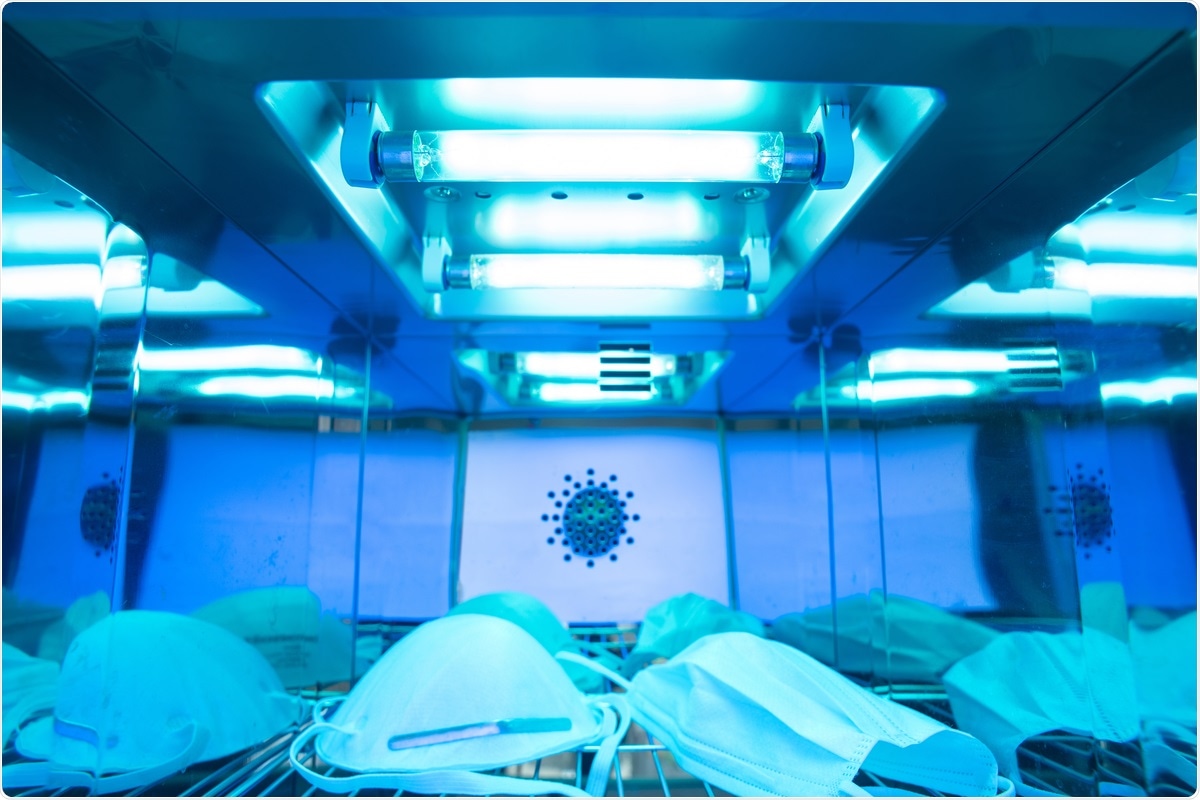The coronavirus disease 2019 (COVID-19) pandemic, caused by severe acute respiratory syndrome coronavirus 2 (SARS-CoV-2), has prompted significant economic, scientific, and public efforts to contain the virus. The inactivation of the virus on surfaces and air might be a very effective tool in fighting the COVID-19 pandemic.
 Study: The Effectiveness of Far-Ultraviolet (UVC) Light Prototype Devices with Different Wavelengths on Disinfecting SARS-CoV-2. Image Credit: Nor Gal/ Shutterstock
Study: The Effectiveness of Far-Ultraviolet (UVC) Light Prototype Devices with Different Wavelengths on Disinfecting SARS-CoV-2. Image Credit: Nor Gal/ Shutterstock
UV disinfection as a chemical-free technology
Several approaches, including heat sterilization, ventilation, chemical disinfectant, and ultraviolet (UV) irradiation, are effective in disinfection. UV disinfection has become a popular chemical-free technology over the last few decades since it is very effective at disinfecting bacteria in the air, water, and surfaces.
Several new UV light air and surface disinfection products have come to the market since the COVID-19 pandemic began. UV surface disinfection systems are used in a range of public places such as hospitals and health care institutions, restaurants, and cafeterias. However, inappropriate use of UV disinfection is very common among the general public and UV surface disinfection manufacturers due to a lack of understanding of its critical features. Far-ultraviolet light (UVC) disinfection is very effective against bacteria and viruses.
In a paper published in the open-access journal Applied Sciences, researchers examined the efficacy of UVC light prototype devices with wavelengths 275, 254, and 222 nm to understand the duration and wavelength of UVC radiation needed for SARS-CoV-2 inactivation. The effectiveness of disinfection was determined using cell-based assays like the median tissue culture infectious dose (TCID50) and an immunofluorescent assay on African green monkey kidney epithelial Vero E6 cells. Among the three prototypes, the UVC LED (275 nm) showed the best virucidal activity with a log-reduction value (LRV) greater than six after an exposure duration of 10 s.
The mercury lamp (254 nm) needed 20 s exposure to reach similar virucidal activity, while the excimer lamp (222 nm) had a LRV < 2 with limited anti-SARS-CoV-2 activity after 40 s of exposure. Overall, the UVC LED (275 nm) exhibited the best SARS-CoV-2 disinfection activity compared to the mercury lamp (254 nm) and the excimer lamp (222 nm).
Effectiveness of UV disinfection
The disinfection effectiveness of UV light is based on the wavelength, with UVC having the shortest wavelength providing the utmost performance within the UV range. UVC devices with short wavelengths disinfect equipment, surfaces, operating rooms, and personal protective equipment (PPE) in healthcare settings.
UVC LEDs in the 254 to 265 nm range provided the most effective disinfection within the UVC range. This study further demonstrated that UVC LEDs (275 nm) showed superior disinfection against SARS-CoV-2 in comparison to mercury lamps (254 nm) and excimer lamps (222 nm).
Challenges with UVC disinfection lighting
Some challenges with UVC disinfection lighting include the following. UVC lamps used in disinfection may be a reason for health and safety concerns depending on their dose, wavelength, and duration of UV exposure. The risk increases further if the UV device is improperly handled or placed. Direct exposure to UVC radiation to the skin and eyes from some UVC lamps can lead to painful eye injury and skin burns.
How UV disinfection can help prevent SARS-CoV-2 infection
Since SARS-CoV-2 is mostly transmitted through droplet or aerosol inhalation, improved indoor air quality through proper ventilation and safer environments are essential to prevent infection. UVC has been widely used in hospitals in light-emitting robots to disinfect operating and patient rooms, medical equipment, and instruments. UVC LEDs can disinfect cars, aircraft, and trains using robots or human-controlled UVC machines to disinfect surfaces. UVC LEDs can also disinfect the air in indoor spaces such as restaurants, schools, shops, and even houses by installing UVC LEDs in air-flow systems. Work is also in progress to develop novel UVC light disinfection technologies that can automate the disinfection process with the help of robots.
Novel UVC air and surface treatment technologies will provide new tools to control the current and future pandemics.”
Journal reference:
-
The Effectiveness of Far-Ultraviolet (UVC) Light Prototype Devices with Different Wavelengths on Disinfecting SARS-CoV-2. Jian-Jong Liang, Chun-Che Liao, Chih-Shin Chang, Chih-Yin Lee, Si-Yu Chen, Shao-Bo Huang, Yin-Fu Yeh, Konthoujam James Singh, Hao-Chung Kuo, Yi-Ling Lin, and Kuang-Mao Lu. Appl. Sci. 2021, 11(22), 10661. doi:https://doi.org/10.3390/app112210661 https://www.mdpi.com/2076-3417/11/22/10661